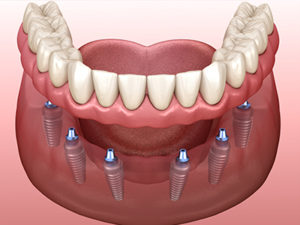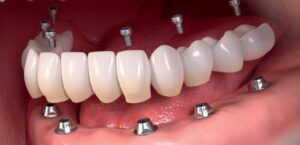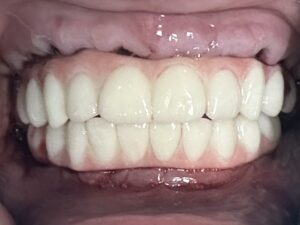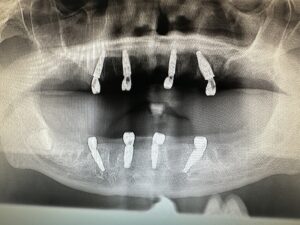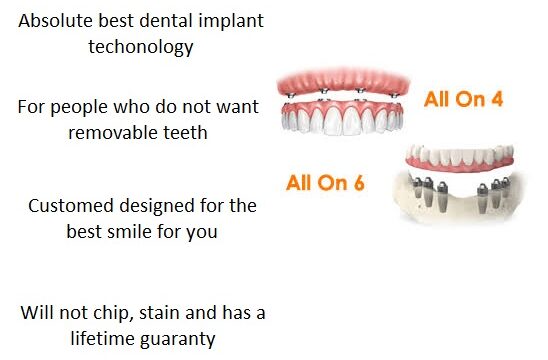
If you’re weighing your options for full mouth restoration, understanding the ‘all on 6 vs all on 4’ dental implants is crucial. This direct comparison will articulate the key differences in stability, bone requirements, and impact on oral health to help you navigate the choice. Expect clear, concise insights to guide your preliminary understanding, setting you up for an informed discussion with your dental specialist.
Key Takeaways
- All on 4 dental implants use four implants with two placed at an angle, while All on 6 implants use six straight-placed implants, offering enhanced stability and strength but may require more bone and potentially bone grafting.
- The success of dental implant procedures is influenced by the precision of implant placement, with digitalization in dentistry playing a key role in diagnostics and treatment planning; All on 6 generally provides better stability and longevity, especially for the upper jaw.
- Choosing between All on 4 and All on 6 involves considering various factors such as cost, patient oral health, and long-term investment value, with satisfaction rates for both procedures being high among patients transitioning from traditional dentures to fixed implants.
Exploring the Basics: All on 4 vs. All on 6 Dental Implants
All on 4 and All on 6 dental implants are procedures that install a full set of teeth on four or six dental implants per arch respectively. These full mouth dental implants, with prosthetic teeth supported by implants permanently placed within the mouth, offer a solution for patients with missing teeth. Unlike traditional dentures, these dental procedures provide a fixed dental prosthesis that looks like natural teeth. For patients considering dental implants in Rockville, these advanced treatments offer a reliable and long-lasting solution for restoring full dental functionality and appearance.
These innovative methods can transform your smile and boost your confidence, regardless of whether you’re replacing one tooth, multiple teeth, or all your teeth.
The Core Differences Between All on 4 and All on 6
While All on 4 and All on 6 dental implants share similarities, they primarily differ in the placement and number of implants. All on 4 implants are strategically placed at an angle, whereas All on 6 implants are placed straight.
The All on 6 dental implant procedure offers enhanced stability and strength over All on 4, which can be attributed to the increase in the number of implants from four to six. However, All on 6 procedures may require more bone for placement and are likelier to necessitate bone grafting compared to All on 4.
Implant Placement Precision
The precision of implant placement is a significant factor in the success of dental implant procedures. All-On-4, also known as the four implants procedure, has two vertical implants in front and two angled implants in the rear, while All-On-6 places six implants in a less angled, more traditional orientation. The strategic placement of implants in the All on 4 procedure is designed to utilize the anterior maxilla area known for higher bone density.
Thanks to digitalization in dentistry, personalized workflows have reduced reliance on dental team skills, potentially revolutionizing diagnostics and treatment planning for dental implants.
Stability and Bone Integration
In terms of stability and bone integration, All-on-6 dental implants surpass All-on-4. They provide a stronger and more stable base for the prosthetic dental arch compared to All-on-4, potentially extending the prosthetic arch’s longevity.
Due to the distribution of pressure between more points, All-on-6 is more suitable for patients with poor jawbone density. However, patients lacking the sufficient bone strength to support the additional two implants required for All-on-6 might find the All-on-4 procedure to be a more suitable option.
Suitability for Upper or Lower Jaw
All-on-6 dental implants provide a stronger, more stable base for the prosthetic dental arch, which is especially advantageous in the upper jaw due to the dynamic forces involved in biting and chewing. The use of six implants in an All-on-6 configuration can extend the life of the prosthetic arch in the upper jaw by ensuring a more even distribution of pressure.
For the lower jaw, choosing All-on-4 or All-on-6 dental implants may hinge on the patient’s jawbone condition, with All-on-6 offering enhanced stability if the bone density is sufficient.
The Journey from Initial Consultation to Final Smile
There are three main stages in the journey from the initial consultation to the final smile with dental implants: pre-surgical assessments, dental implant surgery and recovery, and achieving your beautiful smile with custom-made prostheses. These stages ensure that the procedure is tailored to your specific needs, and that you are well-informed about the process and what to expect throughout your journey.
Pre-Surgical Assessments
The journey towards your new smile begins with an essential step – pre-surgical assessments. During a dental implant consultation, dentists carry out a thorough examination that includes:
- Evaluating bone structure
- Assessing gum health
- Reviewing patients’ overall health status
- Using X-rays and other diagnostic tests to evaluate the condition of a patient’s jawbone and surrounding teeth
Based on these assessments, dentists can recommend the most suitable treatment.
The All-on-4 procedure may be more suitable for patients who lack the necessary bone strength for two additional implants., which is designed to maximize the use of available bone without the need for bone grafting or sinus lifts. Crucial to the pre-surgical assessment is Cone-Beam Computed Tomography (CBCT), a more effective method than panoramic radiography for preoperative implant planning, providing a higher degree of prediction and agreement with the surgical outcome.
Surgical Process and Recovery
During the surgical process, titanium posts are implanted into the jawbone., followed by a healing period and attachment of abutments to anchor the prosthetic teeth. During the healing phase, temporary solutions such as healing abutments or partial plates may be used to protect the implant and maintain aesthetics. Learn how long the dental implant procedure is.
Once the implant has integrated with the jaw bone, final impressions are taken to create the permanent crowns, which will be secured to the implants in a subsequent visit.
During the post-surgery recovery period, patients should:
- Maintain oral hygiene
- Modify their diet
- Avoid strain on the implant sites
- Follow the surgeon’s care recommendations to ensure successful healing.
This will help manage tenderness and discomfort and promote a successful recovery.
Achieving Your Beautiful Smile
Once the healing phase is over, patients advance to the final stage of achieving their beautiful smile. Patients can choose from three different prosthesis options for All-on-4/All-on-6 systems: screw-retained porcelain crowns, screw-retained zirconia crowns, and hybrid prosthesis.
The final fixed teeth are usually attached just 24 hours after surgery, and with proper care and oral hygiene, All-on-4 dental implants can last a lifetime. This stage signifies a substantial improvement in the quality of life, as patients experience a significant improvement in chewing ability, teeth stability, and overall comfort, enabling them to eat without reservations.
Pros and Cons: Weighing Your Options for Dental Implants
Like every dental solution, All on 4 and All on 6 dental implants come with their own set of advantages and potential downsides. Understanding the advantages and potential downsides of each procedure is crucial in making an informed decision that suits your specific needs and circumstances.
Advantages of Each Procedure
All on 4 and All on 6 dental implants come with a host of advantages. Both procedures offer a permanent solution for lost teeth, including:
- Improving appearance
- Jawbone preservation
- Preventing further deterioration of facial structure
- Delivering new teeth that mimic natural teeth in comfort and functionality
- Significantly improving chewing ability and overall comfort.
Plus, they are straightforward to maintain with routine brushing, flossing, and dental visits.
Considerations and Potential Downsides
While the advantages are numerous, it’s also important to consider potential downsides. The All-on-4 treatment, while less expensive than conventional implant methods, represents a sizable financial commitment. Additionally, patients might find it challenging to adapt to the cleaning of multiple porcelain caps attached to each implant in an All-on-4 system due to their non-individualized nature, particularly during flossing.
Financial Factors: Cost Analysis of All on 6 vs. All on 4
When evaluating dental implant options, cost implications are also a necessary factor to consider. All-on-6 is often more expensive than All-on-4 due to the inclusion of two additional implants. The cost may increase further if bone grafting is required, which is not always the case with All-on-4.
However, despite these costs, both procedures are viewed as long-term investments into a patient’s oral health and overall well-being.
Affordability and Insurance Coverage
When choosing dental implants, it’s important to consider factors such as affordability and insurance coverage. Some insurance plans may cover a portion of the cost for All-on-4 dental implants, typically between 30 to 50 percent. However, insurance coverage for dental implants is often dependent on the level of the plan, with basic plans seldom including it, whereas higher-tiered or premier plans are more likely to offer such coverage.
Long-Term Investment Value
Despite a higher initial cost compared to other dental restoration options, All-on-4 and All-on-6 implants are designed to last many years, which may render them more cost-effective over time. The procedures for both All-on-4 and All-on-6 improve chewing ability, speech clarity, and overall dental health, consequently enhancing a patient’s quality of life and self-confidence.
Patient Experiences: From Dentures to Fixed Teeth
Considering patient experiences can provide a more personal perspective on the procedures. Many have transitioned from traditional dentures to more stable solutions like All-on-4 and All-on-6 dental implants.
Unlike traditional dentures, which are removable, fixed dentures offer a more secure attachment to the gums and jaws through dental implants, serving as effective replacement teeth.
Life Before and After Implants
Life before and after implants often involves a significant transformation. Take Rosa for example. She experienced a decline in self-confidence and faced difficulties in social interactions due to the loss of a front tooth.
After receiving her dental implant, Rosa regained her complete smile, restoring her self-confidence and her enjoyment of foods.
Satisfaction Rates and Success Stories
Satisfaction rates and success stories for both All on 4 and All on 6 dental implants are generally high. Steve (pictured above), who underwent a successful All-on-6 dental implant procedure, greatly improved his quality of life. Before receiving All-on-6 implants, Steve experienced self-consciousness about his smile and eating difficulties, which were resolved post-procedure.
Similar success stories and high satisfaction rates have been reported by many patients who received All-on-6 dental implants. See more stories in our smile gallery!
Making the Choice: Expert Advice from a Dental Specialist
Expert advice from a dental specialist is invaluable when deciding between All on 4 and All on 6 dental implants. The decision should be made after a personalized professional consultation, taking into account the patient’s specific oral health condition and individual needs.
Personalized Treatment Planning
Choosing the suitable dental implant procedure requires personalized treatment planning to meet the specific needs of a patient’s mouth and existing conditions. The decision to use All On 4 or All On 6 dental implants is tailored based on:
- the patient’s bone structure
- gum health
- remaining teeth
- the anatomy of their sinus cavity
A comprehensive assessment of the patient’s upper jawbone condition is crucial in determining if All-on-4 or All-on-6 dental implants will provide the optimal outcome.
Consultation with Your Dentist
In making the right choice, a consultation with your dentist is a crucial step. During the consultation, patients are empowered to ask questions and fully understand the risks and benefits of each procedure. The dentist will conduct a thorough examination of the patient’s dental structure and past treatments, using a digital dental passport to ensure personalized prosthetic rehabilitation.
Summary
In summary, while both All on 4 and All on 6 dental implants offer effective solutions for missing teeth, the choice between the two depends on several factors including jawbone condition, patient’s specific needs, and financial considerations. Both procedures provide improved quality of life, confidence, and functionality. Therefore, it’s crucial to have a thorough consultation with a dental specialist to determine the best procedure for you.
Frequently Asked Questions
How much do all-on-6 dental implants cost in the US?
All-On-6® Dental Implants cost approximately $20,000 — $41,000 per jaw in the US, covering pre-surgical workup, the implants, and follow-up care.
What is the success rate of the all-on-6?
The success rate of the all-on-6 procedure is close to 98%, with only a 2% failure rate due to implant rejection.
How many teeth do you get on All-on-4 dental implants?
All-on-4 dental implants can support ten to fourteen teeth, even though there are only four implants placed surgically at one time. This allows for immediate placement of a prosthesis connected to the implants.
Does food get stuck under All-on-4 dental implants?
Yes, food can get stuck under All-on-4 dental implants, but with proper care and precaution, this issue can usually be resolved. Regular maintenance and cleaning can help prevent this problem.
What is the main difference between All on 4 and All on 6 dental implants?
The main difference between All on 4 and All on 6 dental implants is the number and placement of implants. All on 4 uses four implants, with two placed at an angle, whereas All on 6 uses six straightly placed implants.

